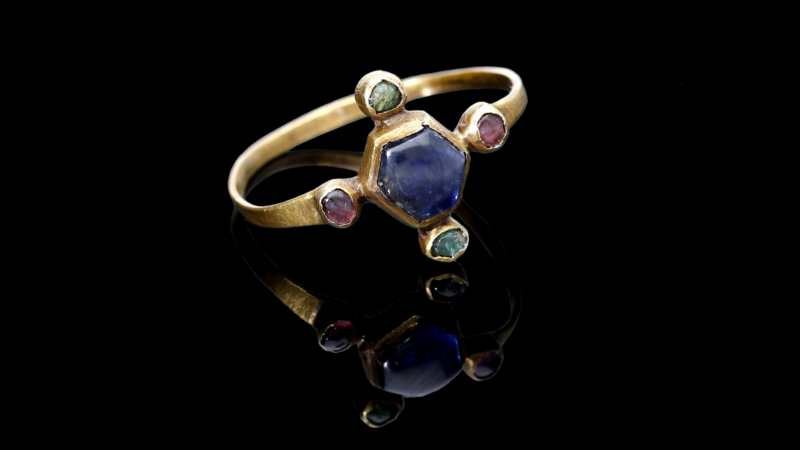A medieval Bishop’s ring from more than 800 years ago goes to auction
It sounds like a dream scenario for your average metal detectorist.
Picture yourself in a field, searching for hidden treasures, when suddenly you spot something shiny. Could it be gold?
For retired firefighter Mark Sell in Norfolk, England, the experience was even more remarkable. He discovered not just gold, but a Medieval Bishop’s ring dating back to the late 12th to early 13th century.
In November, 2019, Sell discovered the rare jewel in immaculate condition, with all its gemstones intact, in Shipdham, Norfolk. The ring was temporarily displayed at a museum dedicated to human history, culture and art. It is now scheduled to be auctioned at Noonans Mayfair, a London auction house, later this month.
Three things to know:
- Sell, 63, was out in a field using his metal detector with a friend when he got a faint signal and decided to dig. “I was amazed to see a thin line of gold in the clod of mud that I had dug up, and as I wiped away the mud, I could see the bezel of a medieval gold jeweled ring,” he told Noonan’s auction house.
- Laura Smith, a jewellery expert at Noonans auction house, explained that the style of jewel setting and its historical context suggest it likely belonged to a Bishop from the 12th or early 13th Century. The ring is set to be auctioned on March 26 and is estimated to fetch between $19,000 and and $23,000, according to the auction house. The profits will be split between Sell and the landowner of the field where the ring was discovered.
- After sharing his find with the landowner, Sell reported it to his local finds liaison officer, who is part of the U.K’s Portable Antiquities Scheme. This program, run by the British Museum, aims to record people’s everyday archeological discoveries into a historical database.
Listen to NPR’s State of the World podcast for a human perspective on global stories in just a few minutes, every weekday.
On display
While the ring was in the care of the British Museum, it was displayed temporarily for public viewing.
According to a Noonan representative, the Norwich Castle Museum has shown interest in acquiring the ring for permanent display. Originally a medieval royal fortification, the museum now serves as an art gallery and showcases significant objects from the region, including works of art, archaeological finds, and natural history specimens
The gold ring features a six-sided central hexagonal cabochon sapphire, complemented by two emeralds and two garnet stones, as described by Sell.
Dive deeper:
- Want more fuel to buy that metal detector? Here’s a story from last year on another fantastic historical find.
- Listen to NPR’s Short Wave podcast for more discoveries, everyday mysteries and the science behind the headlines.
Preliminary report says fuel switches were cut off before Air India Boeing 787 crash
Indian investigators determined the Boeing 787 Dreamliner was properly configured and lifted off normally. But three seconds after takeoff, the engines' fuel switches were cut off.
2 years ago, Amanda Anisimova put down her racket. Now she’s in the Wimbledon final
Anisimova was a teenage tennis prodigy. But by 2023, tournaments had become "unbearable" for her mental health, and she stepped away. Now, she is a win away from her first Grand Slam title.
Guantánamo plea deals for accused 9/11 plotters are canceled by federal appeals court
A federal appeals court has canceled plea deals with three men accused of orchestrating the 9/11 attacks, deepening the legal morass surrounding the long-stalled case.
Gen Z is afraid of sex — and for good reason
Gen Z is in a sex recession. Not because they're less horny, but because they're more afraid.
Nigeria says it won’t accept U.S. deportees: “We have enough problems of our own”
Nigeria's government is pushing back against U.S. efforts to send them migrants and foreign prisoners, with Nigerian Foreign Minister Yusuf Tuggar quoting Public Enemy to drive home his point.
Wet Leg are back with a slick new record
The English band's sophomore album, moisturizer, is out today. Co-founder Rhian Teasdale joins World Cafe to talk about it.







